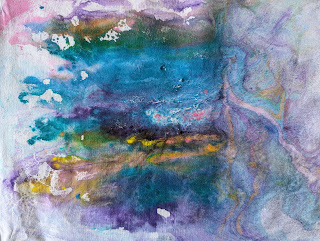I belong to a textile art group in our province of Nova Scotia, Canada. We call ourselves “Textile Artists Collective of Nova Scotia” and we have been meeting once a month (with the exclusion of the summer months) for about 12 years now. It is a great group of a dozen friends and fellow fiber artists that has been a wonderful source of inspiration and feedback for me. I have to drive a 260 km /160 miles roundtrip to get to our central meeting location but it is worth it.
Our group has been exhibiting a couple of times over the
last few years. In 2023 we had a show concurrent to the Quilt Canada convention in
Halifax that was quite successful. Now we are preparing for a show in a gallery
in Lunenburg on the South Shore of Nova Scotia in November.
At our monthly meetings, we strive to often do a hands-on
activity, a small workshop or demo, to introduce our members to new techniques
and to have fun playing with new materials.
At our last meeting, one member had prepared a demo on marbling on fabric. She provided the
materials and we could then try it out for ourselves.
The technique for marbling fabric is not different from marbling
paper, an ancient technique to print colorful and elegant papers. These papers
were often used in bookbinding.
We set up trays with thickened water. The thickening agent
can be Carrageenan (a non-toxic thickener made from seaweed), or methyl
cellulose (aka wallpaper glue). The fabric was mordanted with alum so the paint
would adhere to it better. There are multiple options for marbling paint,
like inks and liquid fabric paints. We used a commercial line, DecoArt Water
Marbling Acrylic Paint, which had a good range of colors and comes in handy
little drop bottles, which are easy to use.
The paint gets dropped onto the surface of the thickened
water and starts to expand and contract and swirl around. We continued filling
the surface with paint until it was to our liking. Then the piece of fabric is placed
on top and immediately soaks up the paint that floated on the surface. The
process was not very controllable as our water mixture was a bit too liquid, so
we could not really make pretty patterns with combs or sticks as they disappeared
almost as soon as we made them. Nevertheless, we had some neat results and enjoyed
trying a fast and easy way to get color onto the white cloth.
Here I am working on dropping the paint onto the surface, and the resulting cloth is below.
Some of the paint had dropped to the bottom of the pan and we used this leftover paint for some “mop-up” prints that can also be quite interesting.
After drying, the paint needs to be heat set so the fabric is ready to use.
I can definitely recommend this quick and fun activity if
you would like to try it!
Photo credit: Fiona Oxford










1 comment:
Regina, Thank you for sharing your marbling process.
Post a Comment